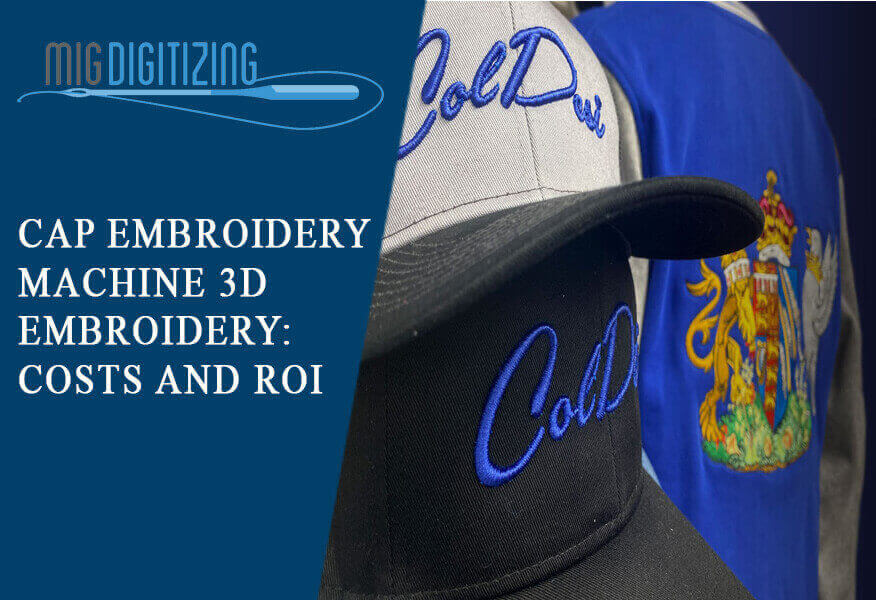
Cap embroidery is a great approach to increase profit in your bespoke apparel business. Furthermore, if you know how to execute it successfully, you can enhance your sales capacity and gain a competitive advantage in your target market. We'll show you how to do master cap embroidery in this tutorial. We begin by examining the many sorts of hats available so that you may choose the right one for your project. After that, we'll go through some quick instructions on how to properly hoop the hat for embroidery. Let's talk about it!
Because the embroidery machine is meant to attach to flat garments, extra care must be taken while embroidering on curved surfaces. However, this does not rule out the possibility of embroidering master caps. There is, however, a better method to go about it. You can use a rubber band to secure the cap once you've hooped it. A customised rubber band isn't required. The same can be done using a rubber band. Take the puff and place it in your design when it's finished. Overlap a section of the rubber band over the top. You are now ready to begin the stitching procedure. When you're finished with the design, you can remove the access foam.
Hats and caps are particularly difficult to produce and are more prone to quality issues. Poor quality might happen faster than you think if you aren't careful.
Choosing Your Embroidery Cap Hat
Variety is the name of the game when it comes to ball caps. You can choose from a variety of colour materials, back closures, crown heights, bill types, combinations, and so forth. There are hundreds, if not thousands, of options on a cap catalogue or website. While there are hundreds of distinct hat types and manufacturers available, the majority of hats fall into one of three categories:
Sports caps for embroidery
Sports caps are the most popular hat style, particularly for embroidery. The front panel of this hat has a centre seam running down the centre. You'll usually drop stitches in the centre seam), and it has a laminated backing for structure.
OPF (One-piece front) hats for embroidery
OPF classifies these hats as "trucker/farmer" headwear. These hats have a foam laminated backing (which gives the hat structure) and a mesh material for the remainder of the hat. Because of the laminated backing and the lack of a centre seam, OPF hats are usually rather straightforward to hoop and embroider.
Varsity/collegiate hats for embroidery
Because there is no laminated backing (structure) on the front of the panel, varsity caps tend to fit a little closer to the head. As a result, these hats have a tendency to move a little bit, which is why appropriate hooping is so vital.
How To Embroider Cap Hats
It goes to reason that there would be a range of placement alternatives when embroidering on caps. Most multi-needle embroidery machines are capable of embroidering the front, both sides, and rear of the cap, as well as most areas in between. Some options are only available as embroidered items prior to the manufacturing process (example: the bill).
The front of caps is the most commonly embroidered section. Most professional embroidery machines now have wide angle cap frames that go most of the way around the cap and rotate 270 degrees.
Mistakes to avoid when embroidering hats
You're Embroidering Machine Is Too Fast
Slowing down is the best advice for creating the best needlework. A machine should stitch at roughly 600 stitches per minute with a hat frame and around 750 stitches per minute with a flat for a common hat design. This is, of course, simply a suggestion. Each design will be unique. If a design contains fine elements or small lettering, you should always slow down your system.
When working with elaborate embroidery designs, slow down to roughly 550 stitches per minute for hat frames and 650 stitches per minute for flats to better registration.
Improper Hooping
When commercial embroidery, particularly headgear, is hooped incorrectly, it will suffer. There can be occasions when a logo or design requires slightly distorted embroidery to appear good. Give these specific items to your hoopers and embroiderers who have the most experience. In the Durkee hoop, hats must keep tight and the hoop must remain straight and centred.
Looking out over the Bobbing
When changing bobbins, make sure the thread tension is correct. Do you use a seatbelt while driving? It's the same situation. If your bobbin is too loose or too tight, the quality of your needlework will suffer. The technique is simple, quick, and necessary for constant quality. Checking becomes second nature once you get into the habit. There's no reason why you shouldn't do it every time!



